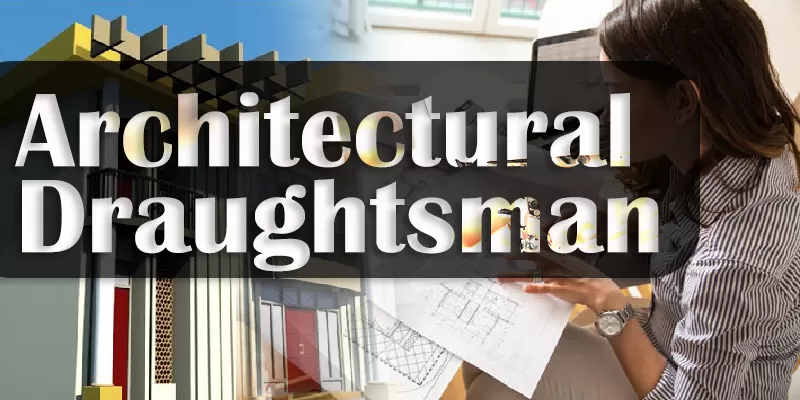
ITI Trade: Architectural Draughtsman
The Architectural Draughtsman trade is powered by NCVT (National Council for Vocational Training). It is a job-oriented trade that opens doors to both government and private sector employment. This course empowers candidates with essential skills, making it a powerful tool for self-employment and entrepreneurship.
The course is perfectly designed to meet the industrial requirements of Indian industries as well as international industries, preparing trainees for a competitive career in architecture and construction sectors.
About the Trade
An Architectural Draughtsman is responsible for preparing accurate scaled drawings of:
- Buildings
- Parks
- Gardens
- Monuments
- Landscape features
These drawings are created from approved sketches, conceptual designs, or engineering data provided by architects and planners.
The role includes studying and interpreting notes, sketches, and technical data related to the projects. The draughtsman transforms these inputs into detailed construction-ready blueprints.
Scope of Employability
An Architectural Draughtsman has a wide scope for employment and entrepreneurship. Successful trainees can find opportunities in:
- Government departments (PWD, CPWD, Municipal Bodies, Urban Development Authorities)
- Private Architectural Firms
- Construction Companies
- Infrastructure and Real Estate Developers
- Self-employment as a freelance draughtsman or consultant
- International placements in Gulf countries, Europe, Australia, New Zealand, and other regions where construction and urban development are booming
Job Roles After Completion
Upon successfully completing the course, candidates may be employed in the following occupations:
- Architectural Draughtsman
- Draftsman in Planning and Survey Departments
- Draftsman in Urban Development Projects
- Junior Architect Assistant
- CAD Operator in Architecture Firms
- Site Supervisor or Coordinator (with experience)
International Comparability
While there is no formal document stating the equivalence of this qualification with other countries, ITI Architectural Draughtsman trainees have secured employment opportunities in:
- Gulf Countries
- European Union
- Australia
- New Zealand
- Singapore
Their skills in drafting, CAD, and construction documentation are recognized globally.
Key Learning Outcomes
- Mastering architectural drafting techniques using manual and CAD tools
- Preparing site plans, floor plans, elevations, sections, and working drawings
- Understanding building materials and construction techniques
- Knowledge of building codes, by-laws, and regulations
- Proficiency in AutoCAD and other design software
- Preparing estimates, BOQs, and tender documents
- Basic knowledge of 3D visualization and model making
Architectural Draughtsman – Course Curriculum
This curriculum is designed to equip trainees with both theoretical knowledge and practical skills in architectural drawing and drafting using traditional methods and advanced software tools like AutoCAD, SketchUp, and Revit.
Block-I: Basic Architectural Drafting Skills
Safety & Fundamentals
- Recognize & comply with safe working practices, environmental regulations, and housekeeping standards.
Drawing Basics
- Draw different types of architectural symbols.
- Create freehand sketches for initial concepts.
- Learn various lettering styles for technical drawings.
- Master plane geometry for architectural purposes.
- Develop orthographic projections for detailed design work.
Building Construction Elements
- Draw different sizes of bricks and brick masonry patterns.
- Illustrate stone masonry techniques.
- Create foundation drawings for various building types.
- Draft carpentry joints used in wooden structures.
- Prepare drawings of wooden doors and windows.
- Illustrate lintels and arches.
Drafting Techniques
- Drafting in CAD (AutoCAD) – introduction to computer-aided design.
- Draw details of Damp Proof Course (DPC) and Waterproofing Treatments at different building locations.
Block-II: Advanced Drafting and Design Applications
Geometric & Structural Detailing
- Draw solids in inclined positions, sections of solids, and surface development of geometrical forms.
- Create plan, elevation, and sectional drawings of toilets in residential buildings.
- Draft site plans with landscaping for residential projects.
- Illustrate vertical sections of external walls for load-bearing and RCC framed structures.
Architectural Components
- Draw detailed staircases – plan, elevation, and construction details.
- Draft flooring details for various building types.
- Produce roof and roof covering details.
- Create door and window details, including frames and joinery.
Project Work with CAD & BIM
- Design residential buildings (single/double storied), post offices, and farmhouses.
- Prepare sanction drawings according to local bye-laws.
- Develop preliminary drawings in AutoCAD.
- Read and interpret structural drawings.
- Create 3D models in SketchUp, including rendering, walkthroughs, and animated views.
- Finalize working drawings for site execution in AutoCAD.
Block-III: Specialized Areas & Professional Skills
Human-Centric Design
- Draft anthropometric and ergonomic layouts for commercial buildings.
- Prepare standard-sized outdoor movement areas like:
- Swimming pools
- Basketball courts
- Badminton courts
- Play areas
Landscape & Site Planning
- Design and develop site plans with landscaping for:
- Residential Apartments
- Primary Schools (AutoCAD)
Structural Jointing & Detailing
- Draw details of construction joints and expansion joints in structures.
Advanced BIM & Rendering
- Prepare 3D models and BOQ (Bill of Quantities) using Revit Architecture.
- Perform rendering in Photoshop – convert drawings to PDF and add visual detailing.
Working Drawings & Layouts
- Develop:
- Kitchen layouts
- Electrical layouts
- Plumbing layouts
- Drainage Waste Vent (DWV) details
Final Phase
- Project Work – comprehensive design and documentation project.
- Revision & Internal Assessment
- Final Examination
